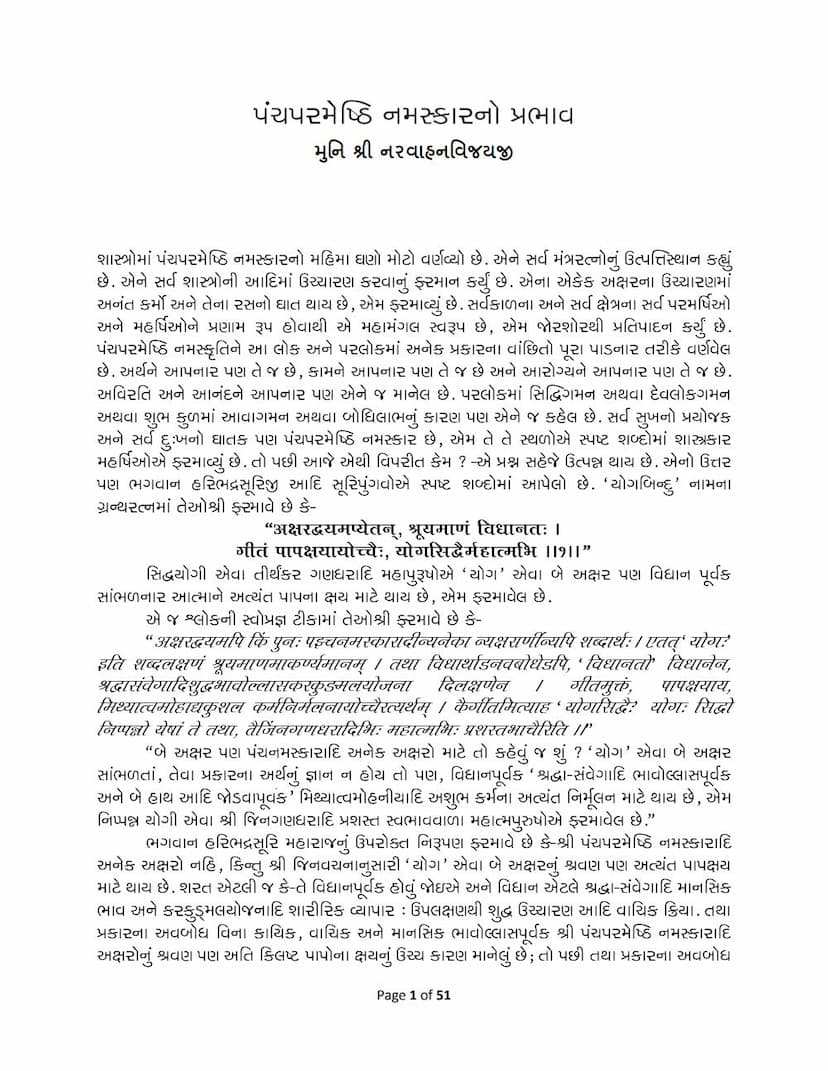Panch Parmeshthi Namaskar Mahamantrano Prabhav
Added to library: September 2, 2025

Summary
This document is an excerpt from the book "Panch Parmeshthi Namaskarano Prabhav" by Muni Shri Narvahanvijayji, published by Narvahanvijay. The text, translated into Gujarati, elaborates on the profound influence and benefits of chanting the Panch Parmeshthi Namaskar, a central mantra in Jainism.
The core message is that the Panch Parmeshthi Namaskar is not merely a mantra but the source of all mantras, the beginning of all scriptures, and a potent force for shedding karmas. It is considered highly auspicious, bestowing worldly pleasures, spiritual attainments, health, and lasting happiness, while eradicating all sorrows.
The author addresses the question of why the mantra might not seem effective today, concluding that the primary reason is ignorance of its meaning and a lack of faith and devotion. The text emphasizes that true benefit comes not just from knowing the meaning but from cultivating sincere faith (Shraddha) and spiritual yearning (Samveg). Even profound knowledge without these qualities renders the mantra ineffective.
The text highlights the importance of "Bhav" (inner feeling/devotion) over "Dravya" (external action). While external rituals are mentioned, the internal state of mind, accompanied by faith, devotion, and proper pronunciation, is paramount. The author quotes various scriptures and scholars to support this point, underscoring that even uttering the two syllables of "Yog" (union) with proper understanding and devotion can lead to the destruction of immense sins, let alone the entire Namaskar mantra.
The author then delves into the practical aspects and detailed explanations of the Panch Parmeshthi Namaskar, including:
- The Significance of Each Letter: The text suggests that the very utterance of each letter of the Namaskar contributes to the destruction of infinite karmas.
- The Importance of Devotion: It stresses that chanting the mantra with faith, sincerity, and proper reverence is crucial.
- Detailed Benefits: The text lists numerous benefits, including protection from dangers, attainment of wealth, health, spiritual progress, and ultimately, liberation (Moksha).
- "Laghu Navkar Phal" and "Brihat Navkar Phal": The book includes two sections detailing the fruits of chanting the Navkar mantra, one concise and the other expansive, illustrating its transformative power.
- The Role of the Guru: The importance of a qualified Guru in guiding the sadhana of the Namaskar mantra is also discussed, along with characteristics of good and bad gurus.
- The Power of Faith and Devotion: The book repeatedly emphasizes that without genuine faith, devotion, and proper understanding, even the most powerful mantra or ritual will yield limited results.
- Theological Debates: Several sections engage in theological discussions, particularly addressing doubts about whether Jin and Siddha are "givers" of fruits of worship, clarifying that karmas are self-created, and external factors are mere facilitators.
- Iconography and Rituals: The text also touches upon the significance of Jina idols, temple construction, rituals of worship, and the proper ways to venerate the Tirthankaras and their virtues.
Ultimately, "Panch Parmeshthi Namaskarano Prabhav" serves as a comprehensive guide to understanding the profound significance of the Panch Parmeshthi Namaskar, urging readers to approach this sacred mantra with deep faith, devotion, and understanding to reap its full spiritual and worldly benefits.